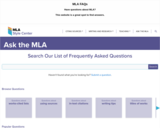
This LO presents a reputable website that consists of frequently asked questions and answers about MLA.
- Subject:
- Composition and Rhetoric
- English Language Arts
- Material Type:
- Interactive
- Provider:
- Michigan Virtual
- Date Added:
- 03/15/2022

This LO presents a reputable website that consists of frequently asked questions and answers about MLA.
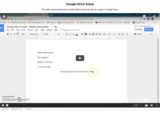
This LO demonstrates how to follow MLA guidelines and set up a paper in Google Docs.
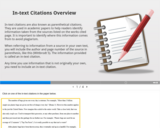
This LO introduces in-text citations and discusses how they connect to the works cited page.

This LO provides a review of the rules that need to be followed to create in-text citations for a variety of sources.

This LO identifies the basic components of an MLA formatted paper and familiarizes students with with MLA terminology.
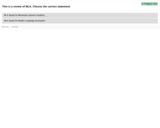
This LO provides a review of the basic MLA guidelines.
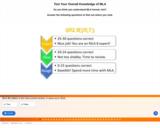
This LO provides 20 questions for students to test their overall knowledge and prowess of MLA 8 format.
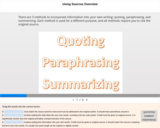
This LO explains the differences between quoting, paraphrasing, and summarizing. It restates the importance of citing sources and provides opportunities for student to practice.
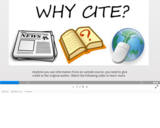
This LO provides background information about why it’s important to cite sources in academic writing.
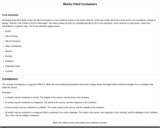
This LO explains how MLA 8 treats citations. It defines a “container” and explains how they are used.
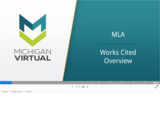
This LO introduces changes to works cited in MLA 8 and examines the connection between the works cited page and in-text citations.

This LO provides a review of the basic rules that need to be followed to create a works cited page for a variety of sources.
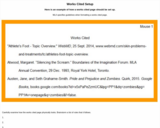
This LO demonstrates how to follow MLA guidelines to set up a works cited page.

In this unit students study the California migrant farm workers’ fight for justice. Lead by Cesar Chavez and Dolores Huerta, this time period is often referred to as the start of the Latino civil rights movement. Over the course of the unit students will explore what life was like for migrant farm workers in the 1960s and the barriers that prevented them from obtaining better wages and equitable working conditions. Students will then learn about how the farm workers were able to band together under the leadership of Larry Itliong, Cesar Chavez, and Dolores Huerta to launch a multi-year movement focused on using nonviolent tactics as a way of making meaningful, long-lasting change. In particular, students will analyze how different types of nonviolent protests (boycotts, pickets, marches, strikes, and fasting) helped educate the public and influence change. Understanding the history of migrant farm workers and their struggle for justice is important for helping students understand the world around them. It is important to note that this unit is based in history. Many of the ideas and concepts in this unit are connected to current events; however, the focus of the unit is on this period in history.
In reading, this unit helps students continue to build their informational reading skills. Over the course of the unit students will be pushed to think about the connection between two or more historical events and people. Unlike previous units, this unit contains a variety of primary sources and videos that require students to use different reading and speaking and listening strategies in order to synthesize and summarize key ideas.

Week 20, Day 1---Day 5
Narrative Writing Unit
"This week we will be writing personal narratives using Judy Moody Saves the World to help us get ideas. Think about the narrative checklist to guide your discussion."
Narrative Checklist Sample
Narrative Graphic Organizer
Ways to establish the situation in a Narrative
Direct statement
Question
Description of snapshot in time
Words and phrases
Dialogue

Natural disasters such as volcanoes, earthquakes, hurricanes, and wildfires happen all over the world. Understanding how natural disasters happen and why helps children feel less anxious and more prepared. Therefore, this unit focuses on teaching students the science behind each natural disaster while also explaining what to do if they live in an area prone to a particular natural disaster. Over the course of the unit, students hear about many famous natural disasters, but the unit places more of an emphasis on how the disasters happen rather than exploring the devastation or destruction caused by previous natural disasters. The unit provides many opportunities for students to learn more about recent natural disasters, including a culminating research project.
The texts in this unit were chosen because of their wide variety of text features, content, and accessibility. Over the course of the unit, students will read texts that are very technical and rely heavily on text features, diagrams, and illustrations, as well as texts that are written as informational narratives. Students will be challenged to think about the structures the authors use to help the reader interact with and learn the content. Additionally, students will learn the importance of referring to specific details from the text and using those details to explain and teach back the newly learned material. This unit serves as the foundation for building strong reading habits and routines and setting high expectations for text consumption. Clear models should be included in the unit to help students build a deeper understanding of how to actively read and annotate informational texts for key ideas, text features, and vocabulary. This unit also serves as a launching point for strong discussions. Students will frequently be challenged to debate questions from the text; therefore, strong habits of discussion need to be introduced over the course of the unit.

WEEK 10, DAYS 1-5
Natural Disasters Research Project
We just finished reading about one type of natural disaster, earthquakes, and today we will discuss other types of natural disasters.
You will choose the one that interests you the most and conduct research to learn more information. To help you learn a little bit about the different types of natural disasters we are going to view a video. You will use a graphic organizer to jot notes about each natural disaster to help you decide which one you want to research and learn more about.
Today you are going to choose one natural disaster to begin researching.
Now that you have chosen your natural disaster you are going to start researching. We are going to use the same graphic organizer we always do, but we are going to use it to help make a plan and organize our notes. Students will work on researching their natural disaster.
Students will work on either finishing up gathering information OR choosing which information to share.
Students will work around the room on either their graphic organizer or their draft. completed their graphic organizer and add new details, facts, and definitions to their graphic organizer.

In this unit, students explore the meaning of family, community, and identity by reading the core text One Crazy Summer. Through the eyes of eleven-year-old Delphine, readers experience life in Oakland, California, in 1968, the height of the Black Panther movement. Delphine and her two younger sisters, Vonetta and Fern, spend a summer in Oakland visiting their estranged mother who sends them to spend their days at a camp run by the Black Panthers. Over the course of the summer, the girls learn about what it means to be part of a revolution, what the Black Panther Party was fighting for, and why the Black Panther Party was important during this time period. Through it all, they build confidence in themselves and their relationships with others as they learn to challenge and respond to social issues in the community. It is our hope that this unit, in conjunction with others in the series, will help students understand the way experiences shape our identities and beliefs, and how children can help bring about change in the community.
In reading, this unit continues to build on reading strategies and skills covered in previous units. It is assumed that students are able to quote or paraphrase accurately from the text, interpret figurative language, and summarize sections of the text. These skills should continue to be spiraled throughout the unit; however, the main focuses for this unit are determining theme and analyzing how it is developed over the course of the novel or poem, analyzing point of view and the impact it has on the way events are portrayed, and comparing characters and their responses to situations.

Week 24, Day 1---Day 5
Opinion Writing Unit
We often think about making good choices.
Today we are going to use a graphic organizer and the opinion checklist to plan this opinion piece
Book Review Graphic Organizer
Opinion Checklist Sample
Today we are going to write to convince people that either it is easy to make the right choice or that sometimes it is hard to make the right choice.
Strong words:
I strongly believe
From my point of view
It’s my belief
Based on what I know
I am convinced
Speaking for myself
I am confident that
Ways you can end an opinion piece: reinforcement, lasting thought, quotation, question.
Students will work on revising, editing, peer revising and editing, and finishing up their final copy.

Learning to Write Opinions
Students will write about "injustice."
Make a graphic organizer model
Opinion Checklist Sample
Students will work on creating their opinion graphic organizer. They will work with or near peers who share their opinion so that they have peers to share ideas with.
Writing reasons that show strong support for opinion.
Plan the conclusion and begin drafting
Ways to end an opinion piece: reinforcement, lasting thought, quotation, question, humor.
Transition Words for Opinion Texts
Students will work on revising, editing, peer revising and editing, and finishing up their final copy
Sharing